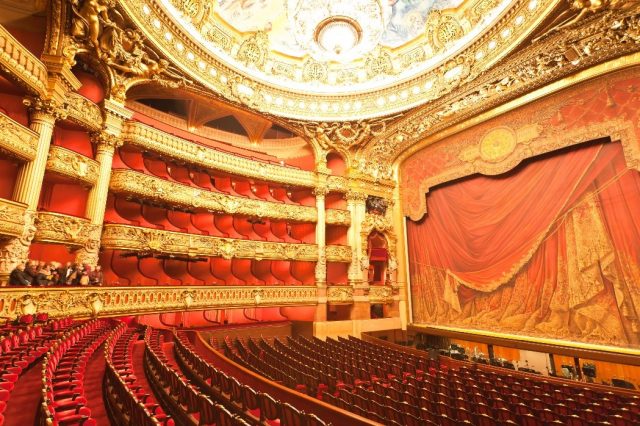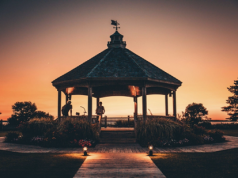As an opera director, Nicholas Muni, has studied and remains fascinated by the rich history of opera. For more than 400 years, people have gathered to witness opera in the theater, and for the past 130 years have also enjoyed it via electronic media, demonstrating that opera not only has staying power but possesses an impressive ability to adapt and respond to evolving technology and social conditions. Nic Muni states “As the original multi-media art form, everyone should at least give an opera performance a chance”. While opera’s popularity has ebbed and flowed throughout history, Nicholas Muni will provide a brief overview of the history of the art form, demonstrating why he remains enthusiastically committed to it.
Opera had its origin in Italy, during the Renaissance, beginning as “opera da camera” (literally “work in a room”) presented in large halls within the lavish residences of wealthy aristocrats and quickly moving into large theaters created especially for its presentation. The first opera is generally credited to an artist named Jacopo Peri, who composed Dafne in 1597, requiring a wide range of artists collaborating to present a lavish spectacle, which included orchestral music, solo and choral vocals, dance, drama, and the visual arts in the form of scenery and costumes. This new art form was an instant hit, with two different styles eventually taking shape: stately operas of a serious, dramatic nature and comic sketches that provided relief from the tragedies, often presented before the serious work or as an intermezzo between the acts of the drama. The more serious works became known as “opera seria” and the comic pieces evolved into full-length pieces in their own right, called “opera buffa”. The serious operatic dramas were mostly enjoyed, and sponsored, by wealthy aristocrats while the comedic works were generally more attended, and supported, by the common public in large theaters. As opera developed, both forms were presented in large theaters and attended by a mixture of the upper class and the commoners. The aristocrats sat in “boxes” usually positioned one level above the ground floor while the bourgeoning merchant class sat on the ground floor and the less wealthy commoners sat in balconies located above the boxes. This physical structure in theaters generally continues to this day, and while (thankfully) the social divisions have disappeared, there still exists an economic segregation. The floor level (called the “orchestra level”) and the box seats are generally far more expensive than the balcony seats.
Nicholas Muni notes that while opera originated in the Renaissance era, it truly hit its stride in the Baroque era. From 1620-1750, most of Europe presented operas featuring the music of some of the greatest composers in history, among them Handel, Vivaldi and Rameau. Because working in the theater was not considered “proper” for females, a curious tradition developed. Dating back to Shakespeare, female roles were generally portrayed by males, but opera took this tradition a brutal step forward with the invention of “castrati”, males singers who were castrated before puberty so that their voices would not change. This enabled males to sing in the alto and soprano vocal register—but with a vocal power and an ability to sing much longer musical phrases due to their larger lung capacity. For this reason, composers wrote music of extraordinary difficulty and virtuosity for female characters and male characters were mostly relegated to supporting roles. During this period, Castrati ruled the day and were paid enormous sums of money—they were the superstars of that time and were even prized as lovers for women because impregnation was impossible. In fact, being a castrato was so lucrative that many families castrated male children shortly after birth, even before knowing whether that child had any musical or vocal talent, to gamble on a future of wealth and notoriety. According to Nic Muni “This practice was eventually outlawed during the 19th century but there do exist a few audio recordings of castrati made at the very end of the 19th century, and the sound is startling. Nowadays, castrato roles are generally performed by either women or countertenors, men who can naturally sing in the alto or soprano vocal register”.
As with the development of musical styles, the plots of opera have evolved over the course of times. For the first 200 years, the subject matter of operas, especially opera seria, were strictly drawn on mythological themes and the principal characters were exclusively “noble”, either Gods or aristocrats. Minor or comic characters were generally of the lower class. Starting with the Classical period and the Age of Enlightenment, operas began to focus on plots that were more “realistic” to provide the growing audience of common folk with characters to whom they could more easily relate. No composer was more important to the Classical period or more instrumental in this shift in storytelling than Wolfgang Amadeus Mozart. His music bridged the Baroque style to the Romantic style by utilizing the structure of previous traditions but filling this structure with revolutionary musical details, providing a necessary seismic shock of modernity that catapulted opera into the next phase of its development. Probably the opera that epitomized this shift best is Le Nozze di Figaro (The Marriage of Figaro) in which two servant characters took on the principal roles within a storyline in which servants defeated the aristocracy.
The Romantic Period (1820-1900) was the second pinnacle of opera and Nicholas Muni notes that opera became more lavish, more political, and much more popular. It was during this period that opera enjoyed unprecedented popular appeal and the creation of opera works exploded. On a visual level, scenery and costuming radically advanced and added more extensive lighting and special effects. The music included a much more significant role for the orchestra and vocal virtuosity prevailed.
At the beginning of this “golden age” of opera the style called Bel Canto (literally “beautiful song”) dominated. In this style, the human voice was featured. Now female singers took on female roles and the music was crafted to their strengths, which were delicacy, flexibility and extreme high register singing. Gioachino Rossini was one of the pioneers of this style and while he composed many serious operas, he excelled in comedy and farce such as The Barber of Seville. On the serious side of opera, an interesting trend developed: the female as social victim. In many of these plots, the heroine was driven mad by an unsolvable romantic-social dilemma, resulting in a climactic “mad scene” and subsequent death. Probably the most famous of these is Lucia di Lammermoor, where the leading lady is forced into marriage and then brutally murders her husband on the wedding night. These mad scenes organically allowed the exploitation and extreme use of the voice in a wide spectrum of expression as well as demanding a high level of acting ability.
By the late 19th century, two titans of opera were leading the way with Italy’s Giuseppe Verdi and Germany’s Richard Wagner. Both born in 1813, these two men created complex characters who captured the human experience and all the beauty and pain that comes with it. The music of both composers is firmly based in bel canto traditions but exploited the use of the voice in another direction, that of the extreme dramatic range and they also vastly expanded the use of the orchestra, elevating it to a leading role in the overall musical expression. Both also looked backward into European political history, Shakespeare and mythological sources but transformed them into fully modern and even futuristic stories, inspiring the next generation of composers to put as much care into the dramatic aspects of opera as they did into the musical values. Verdi, whose operas include Rigoletto, Il Trovatore and Aida as well as three Shakespearean works (Macbeth, Othello and Falstaff), wrote in a tuneful and dramatic style, being particularly sensitive to the psychological aspects of every character. In one of his most popular operas, La Traviata, which tells the story of Violetta, a beautiful courtesan who is fatally ill with tuberculosis, he also demonstrated how modern he was by setting the story at the time of the composition, an approach unheard of at the time and which resulted in the failure of the initial performances. With this choice, however, he determined that opera could, and should, deal with contemporary social and political issues. His operas played a critical inspirational role in the defeat of the Austrian occupying forces and the unification of Italy as a country. He even served as a senator for the newly formed country.
Wagner revolutionized opera in a different way, reaching back into (mosty) Norse mythology for his inspiration but flinging it into the future with interpretations that highlighted contemporary psychological trends and futuristic social commentary. His beliefs in what opera should be were so extreme that he had to invent a new type of theater in which to present them. He convinced King Ludwig of Bavaria to build this revolutionary opera theater in Bayreuth. In this theater, the houselights were turned off for the first time in operatic history and the orchestra was placed in such a way that it was invisible to the audience, another innovation. Lastly, while there remain box seats, they are no longer positioned on the sides of the audience–all the seats were now placed to directly face the stage. The result was that for the first time in the history of opera, the entire focus of the audience was directed at what was occurring on stage and not on other members of the audience or the orchestra.
The verismo period of opera featured “slice of life” stories and embraced rather than shied away from characters of the most common level of humanity. No longer did Gods, Kings and aristocrats dominate the list of characters, but rather seamstresses, farmers, bohemians, and soldiers. Chief among these composers was Giacomo Puccini, who popularized operas to an extent never previously experienced. Interesting to note that Andrew Lloyd Webber was sued by the Puccini Foundation for plagiarizing the work of Puccini!
The 20th century brought about numerous operas that imitated life, criticized political and social trends and which often upset those in power. The Soviet Government famously condemned a 1934 opera by Dmitri Shostakovich called Lady Macbeth of the Mtsenk District. Near the end of the century, John Adam’s Nixon in China detailed President Nixon’s visit to meet Chairman Mao in a way that only the operatic form can do. More recently, operas featuring stories about transgender people (As One) and openly LGBTQ characters (Fellow Travelers) have become much more common.
Opera will continue to provide an outlet for artistic expression at the highest level. While plenty of opera performances are available online, Nicholas Muni encourages everyone to visit the theater to truly understand why opera has continued to endure and thrive for over 400 years. Nicholas Muni can’t wait to see where the opera will head in the future.






